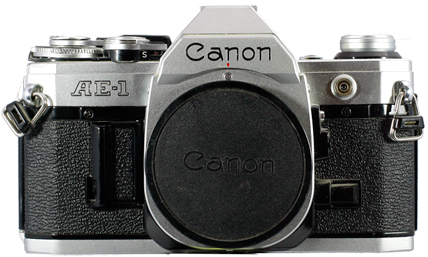
Lens Mount: FD bayonet/breech
Format: 35mm film
Battery: one PX28 or equivalent
Approx. dates of manufacture: 1976 - 1985
Approx. original price: $225
Approx. street value: Moderate
My first real camera, a Christmas gift when I was (I think) 15. I'd had a camera collection since I was little but it was a boxload of Kodak Brownies and such—the sort of thing a kid could pick up at garage sales for $5.00.
I ran a lot of film through this machine, punched through the tripod mounting socket because the tripod screw was too long, and came close to letting a battery leak and eat it up. But, all in all, it's been faithful and reliable and it's been everywhere I've been. I don't hesitate to recommend it to anyone.
By the mid-70s Canon was still making F-series cameras, but they decided to go in a different direction. The F-series cameras were all very much of the 60s: all (or primarily) metal, rather big and heavy and mechanical. Even the electronic EF from 1974 was a substantial camera.
In 1976 they brought out the AE-1, which rocked the photo market. It was smaller and lighter than the F-series Canons. It used a lot more plastic and composite parts than metal, which saved a lot of weight. Yet they engineered it so that it was still rugged and well made. It wouldn't necessarily take the pounding that an F-1 or even an FTb might take, but it wasn't a professional camera. It was aimed at a broader market that wouldn't expect National Geographic performance from it.
.jpg) The AE-1 was a huge success, and it began the crossover market in the late 70s and early 80s where people who
might normally have used simple rangefinder cameras or point-n-shoots, instead found themselves comfortable using a quality 35mm SLR. The
AE-1 had an intelligent semi-automatic
exposure mode: you pick the shutter and it would pick the aperture, yet it still had full manual control. It had an aperture scale within the
viewfinder instead of that often irritating match-needle metering. The camera was light and well balanced and fit the hand well. In short, it
was beautifully designed.
The AE-1 was a huge success, and it began the crossover market in the late 70s and early 80s where people who
might normally have used simple rangefinder cameras or point-n-shoots, instead found themselves comfortable using a quality 35mm SLR. The
AE-1 had an intelligent semi-automatic
exposure mode: you pick the shutter and it would pick the aperture, yet it still had full manual control. It had an aperture scale within the
viewfinder instead of that often irritating match-needle metering. The camera was light and well balanced and fit the hand well. In short, it
was beautifully designed.
And it took the full range of Canon FD-mount lenses. That didn't suck. And it had a nice range of dedicated flash units, from the cheapy little office-party popper 133A through a bounce-head 199A to the potato-masher 577G. And it could be fitted with a fairly inexpensive autowinder, and a special back that would flash the date (or a user-defined code) onto each exposure. It was simple but expandable.
The success of the AE-1 launched the A-series cameras, which would dominate Canon's line for the next decade, and its influence on subsequent products and on its competitors can't be overestimated.
The AE-1 should not be confused with the AE-1 Program, which was an entirely different camera.
For more information: Canon Camera Museum
Modern Photography magazine camera test: September 1976
Modern Photography magazine "SLR Notebook" camera article: December 1976
One of Modern Photography magazine's Top Cameras
Camera manual: Orphan Cameras.com



